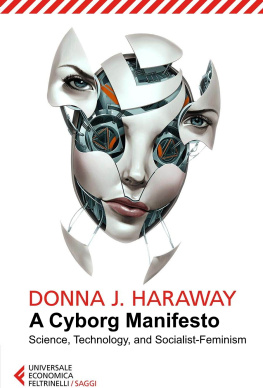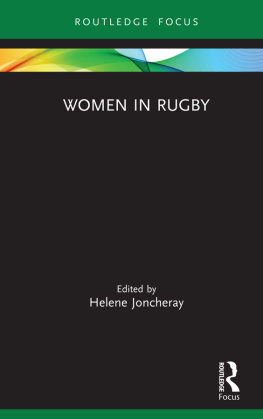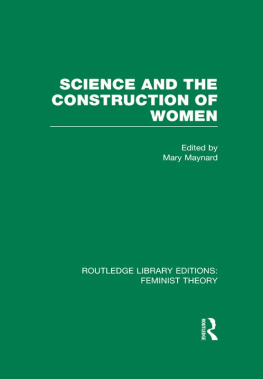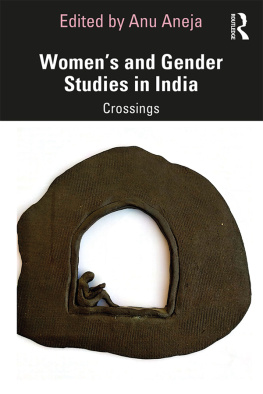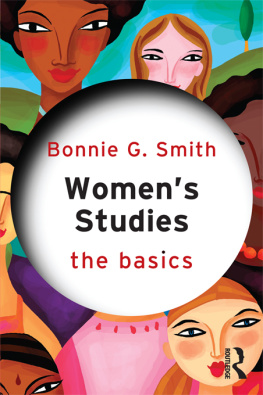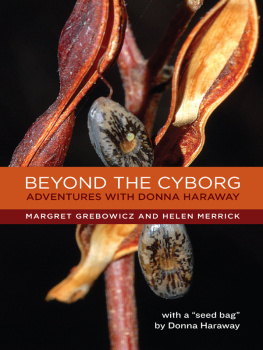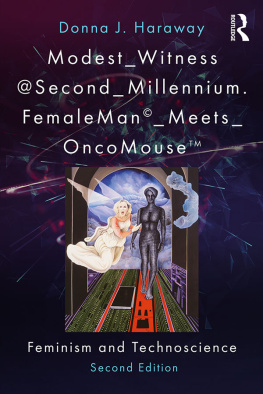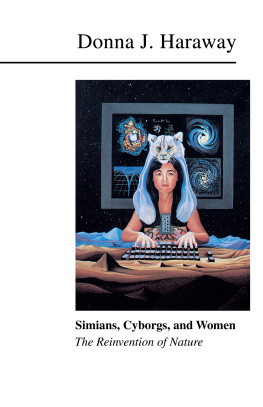PRIMATE
VISIONS
PRIMATE
VISIONS
Gender, Race, and
Nature in the World
of Modern Science
DONNA HARAWAY
ROUTLEDGE
New York London
FOR E.R.H. AND B.J.M.
First published in 1989 by
Routledge
an imprint of
Routledge, Chapman & Hall, Inc.,
29 West 35 Street
New York, NY 10001
Published in Great Britain by
Routledge
11 New Fetter Lane
London EC4P 4EE
1989 by Routledge, Chapman & Hall, Inc.
Printed in the United States of America
All rights reserved. No part of this book may be reprinted or reproduced or utilized in any form or by any electronic, mechanical or other means, now known or hereafter invented, including photocopying and recording, or in any information storage or retrieval system, without permission in writing from the publisher.
Library of Congress Cataloging in Publication Data
Haraway, Donna Jeanne.
Primate visions : gender, race, and nature in the world of modern science Donna J. Haraway.
p. cm.
Bibliography : p.
Includes index.
ISBN 0-415-90114-6: 0-415-90294-0
1. Primates. 2. PrimatesResearchHistory. 3. Feminism. 4. Sociobiology. I. Title.
QL737.P9H245 1989
599.8'072dc20
89-10079
CIP
British Library cataloging in publication data also available.
CONTENTS
ACKNOWLEDGMENTS
Primate Visions began to germinate about 1978, and many people and institutions have contributed enormously. Colleagues and students at Johns Hopkins and the Universit de Montral taught me the pleasure of writing and teaching the history of science, particularly William Coleman, Stephen Cross, Robert Kargon, Camille Limoges, and Philip Pauly. I am especially grateful to the academic community in the History of Consciousness Board and in the Womens Studies Program at the University of California at Santa Cruz. Teaching with Jim Clifford on the traffic between nature and culture has been a special pleasure; and my writing has been stimulated and informed also by the colleagueship of Bettina Aptheker, Norman O. Brown, Teresa de Lauretis, Barbara Epstein, Gary Lease, Helene Moglen, and Hayden White. A warm thanks also to Billie Haris.
The graduate seminars in feminist theory in History of Consciousness have been uniquely valuable. Engaging with students over several years, a faculty member is privileged to read papers and take part in conversations that fundamentally change ones way of seeing. This is a delicate, multidirectional, and collective process. It is impossible adequately to state my debt, and naming a few students leaves unacknowledged many others whose work deeply informs my own. But I must thank especially those with whom I have worked closely who will have finished their doctorates by the time Primate Visions is published: Sandra Azeredo, Elizabeth Bird, Lisa Bloom, Catherine Borchert, Mary Crane, Paul Edwards, Elliott Butler-Evans, Ruth Fran-kenberg, Debbie Gordon, Valerie Hartouni, Caren Kaplan, Katie King, Carole McCann, Lata Mani, Chela Sandoval, Zoe Sofoulis, and Noel Sturgeon. The notes and bibliography only hint at the intellectual generosity of these and other History of Consciousness students.
This book has also drawn significantly from the work of UCSC faculty and students in the Group for the Critical Study of Colonial Discourse and the Feminist Studies Organized Research Activity. Thanks also to Nathalie Magnan and Sarah Williams, who in helping produce a Paper Tiger Television program made me think through my arguments and images.
I have relied extensively on the help of primate scientists, scholars in science studies, photographers, librarians, archivists, and artists. I owe special thanks to those who submitted to interviews, gave me access to unpublished material, supplied photographs, and criticized drafts of chapters. In particular, I am grateful to Jeanne Altmann, Stuart Altmann, Pamela Asquith, Linda Fedigan, Sarah Blaffer Hrdy, Alison Jolly, Lita Osmundsen, Barbara Smuts, Shirley Strum, Sherwood Washburn, and Adrienne Zihlman.
A crucial network of friends and colleagues has read drafts, criticized arguments, offered insights, and generally sustained the intellectual and emotional work of this project. Reading every word critically, Joan Scott has had a major impact. Her friendship and intellectual acumen are a rare gift. I am also fundamentally grateful to Lila Abu-Lughod, Judith Butler, Scott Gilbert, Nancy Hartsock, Dorinne Kondo, Bruno Latour, Rayna Rapp, David Schneider, Dorothy Stein, George Stocking, Marilyn Strathern, and Robert Young.
The heterogeneous, contentious, and wonderful people in science studies who are working in relation to feminist questions have been especially important. Primate Visions is particularly in conversation with Ruth Bleier, Anne Fausto-Sterling, Elizabeth Fee, Sandra Harding, Ruth Hubbard, Ludamilla Jordanova, Evelyn Fox Keller, Diana Long, Helen Longino, Hilary Rose, and Sharon Traweek.
Financial help, allowing the time and other resources to write, has been provided by grants from the Academic Senate of the University of California, the Alpha Fund of the Institute for Advanced Study in Princeton, NJ, and the Wenner-Gren Foundation for Anthropological Research. Faced with a monster manuscript, William Germano at Routledge has provided editorial guidance, intellectual stimulus, and a fine sense of humor throughout.
Members of my households in Honolulu, Baltimore, Santa Cruz, and Healdsburg have given intellectual, personal, and political support over two decades. It is they, especially Rusten Hogness and Jaye Miller, who sustain my sense of possibility in the human regions of the primate order.
Sections of Primate Visions have been previously or simultaneously published in the following essays. All have been edited for Primate Visions, some extensively as noted, and are reprinted with permission. : Sarah Blaffer Hrdy and Sociobiological Feminism: Investment Strategies for the Evolving Portfolio of Primate Females, in Mary Jacobus, Evelyn Fox Keller, and Sally Shuttleworth, eds., Women, Science, and the Body (New York: Routledge, forthcoming 1989).
1
INTRODUCTION:
THE PERSISTENCE OF VISION
The names you uncaged primates give things affect your attitude to them forever after. (Herschberger 1970 [1948])
For thus all things must begin, with an act of love. (Marais 1980)
How are love, power, and science intertwined in the constructions of nature in the late twentieth century? What may count as nature for late industrial people? What forms does love of nature take in particular historical contexts? For whom and at what cost? In what specific places, out of which social and intellectual histories, and with what tools is nature constructed as an object of erotic and intellectual desire? How do the terrible marks of gender and race enable and constrain love and knowledge in particular cultural traditions, including the modem natural sciences? Who may contest for what the body of nature will be? These questions guide my history of the modern sciences and popular cultures emerging from accounts of the bodies and lives of monkeys and apes.
The themes of race, sexuality, gender, nation, family, and class have been written into the body of nature in western life sciences since the eighteenth century. In the wake of post-World War II decolonization, local and global feminist and anti-racist movements, nuclear and environmental threats, and broad consciousness of the fragility of earths webs of life, nature remains a crucially important and deeply contested myth and reality. How do material and symbolic threads interweave in the fabric of late twentieth-century nature for industrial people?


